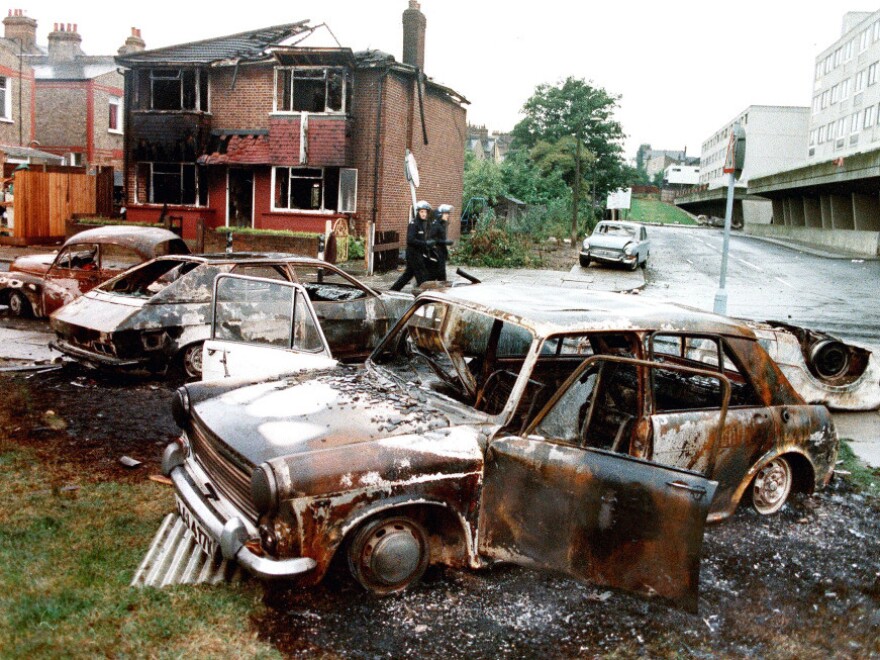Sophia Jones blogs for Foreign Policy.
Masked youth wander the streets armed with Molotov cocktails, families flee as their homes erupt in flames, medics tend to the bloodied and bruised as armored vehicles patrol the streets — a scene fit for a war zone. The world has been captivated by the scenes emerging from London, Manchester, and Birmingham in recent days while the British public has searched for explanations for what set off this wave of anarchy.
But shocking as the violence has been, this isn't the first time England has been paralyzed by riots — history seems to be repeating itself with terrifying accuracy.
St. Pauls Riot
In April of 1980, the Black and White Café, a famous drug den in Bristol, was raided by officers. High unemployment, poor living conditions and a general feeling of discrimination by the police force proved a deadly combination as over a hundred youth battled with officers, destroying police cars and fire trucks as well as local buildings.
In total twenty-five people were hospitalized, including 19 officers, and 130 were arrested. While the numbers were relatively low compared to later riots, St. Pauls would be seen as a turning point.
1981 Summer Riots
The "sus" law — short for suspected person — was a police method that allowed individuals to be stopped and searched without just cause, generating a harsh division between the police and minority communities in the late 1970s and early 1980s. April marked the introduction of a new tactic, called Operation Swamp, where police patrolled the streets in large groups, arresting thousands of suspected criminals in order to slash the crime rate.
On the evening of April 10 in Brixton, as officers led a young black man suffering from stab wounds to a police car to take him to a hospital, he broke free, fearing he was actually being arrested. A crowd began to form around the scene, throwing bottles and bricks at the policemen. As the night went on, rumors spread like wildfire throughout Brixton that the injured man had actually been stabbed by the White officers.
Operation Swamp searches ensued and when officers attempt to search a man suspected of carrying drugs, a full-fledged riot broke with Molotov cocktails being thrown for the first time on the mainland in British history. Hundreds of homes and buildings were looted and torched. 300 officers were injured, along with 60 civilians. Riots spread to areas of Birmingham, Leeds and Liverpool in the later months.
Broadwater Farm
On October 5, 1985, police raided the home of Cynthia Jarrett, a woman of Afro-Caribbean descent whose son had just been arrested. She lived on the Broadwater Farm estate, a dense housing unit in Tottenham, once known as one of the worst places to live in England. As police searched the woman's house, she collapsed and died of a heart attack, prompting public outcry in the community. Cynthia Jarrett's daughter reported that police officers pushed her mother to the ground. The following day, relatives led a peaceful protest to the police station in Tottenham, but the peace didn't last long.
Hundreds of people began to riot, angered by not only Cynthia Jarrett's death, but also the police shooting of an innocent Jamaican woman at her home in South London a week earlier, leaving her paralyzed from the waist down. A string of looting, violence against journalists and armed confrontations with police ended with the brutal death of police constable, Keith Blakelock, who was stabbed 42 times as rioters tried to decapitate him with machetes. For months after the incident, hundreds of people were arrested and interrogated.
The Oldham Riots
Around 572 race-related crimes were recorded in 2000 in the town of Oldham, home to a strong South Asian population. While racial violence was not uncommon, May 26, 2001, marked a particularly deadly day of protests, spurred by a small quarrel between young White and Asian men outside of chip shop. A series of small attacks followed, many at the hands of White youth, and in the matter of hours, an army of 500 Asian men were confronted by riot police, dogs and helicopters in the streets of Oldham. Upwards of 300 people were injured, and hundreds arrested.
Tony Blair blamed White extremists for instigating violence in Oldham, but insisted that young Asians should refrain from participating in racially driven conflict. Following the Oldham violence, similar protests broke out in Bradford and Leeds.
England seems to be suffering from a deadly case of deja vu, or perhaps, a wake up call. As the British struggle to restore order, and begin to digest the devastation, the underlying causes of the riots must be addressed, or these won't be the last riots to rip apart the streets and hearts of London.
Copyright 2020 Foreign Policy. To see more, visit . 9(MDAxNDQ2NDAxMDEyNzU2NzM2ODA3ZGI1ZA001))


